You are here
A Look at Central Bank Gold Reserves
By Ed Wener
Last week in a Midas commentary we saw a brief paragraph
with a quote from the CPM group. I have not seen any reaction to this news.
I believe the message from the CPM Group is important to Gold investors so
I decided to do a little research into the opaque world of Central Bank Gold
and share it with you. Here is the CPM quote. To maintain consistency throughout
this article Ive added (in brackets) the Gold equivalents in tonnes :
The likelihood of lower central bank gold sales could keep prices firm.
These banks sold an average of 14-mil oz/year (435 tonnes) since 1989.
For 2005, net central bank sales may be 6-mil to 8-mil oz (186 to 248 tonnes),
about half of the 12.5-mil oz (388 tonnes) sold last year and less than half
of what has been coming into the market on average over the past 15 years.
"This reduction in physical gold sales by central banks should contribute
to tighter physical markets, and exert some upward pressure on prices,"
said CPM. " While central banks still own more than 1-bil oz of gold
(31,100 tonnes), most appear content to hold on to most of what
they have. There are a few small sales from smaller European national
banks, and the French commitment to sell, announced last April. Other than
that, however, there is no clear source for massive gold sales from official
inventories this year, or in the near future." Also, the potential
sale of IMF gold has been bogged down in international politics and is unlikely
to occur any time soon.
What is the CPM group telling us? Well, implicit in the first sentence is
the fact that Gold was NOT FIRM because of previous Gold sales. In other
words, it was these Central Banks that kept the Gold price from rising. Average
sales of 435 tonnes per year totals 6500 tonnes over the period. According
to the World Gold Council Central Banks had 35,582 tonnes in 1990 and 31,423
as of March 2005. They are only admitting to sales of 4159 tonnes, not
6500 tonnes. The difference is 2300 tonnes.
Then the CPM estimates 2005 Gold sales of less than 250 tonnes which is half
the amount allocated under the 2nd Washington Agreement. This
is VERY bullish for Gold. Gold investors have long waited
for the end of Central Bank dishoarding. Is this really it? Can we learn
something from past behaviour of the Central Banks? The CPM group, like many
others, likes to lump all Central Banks together and scare us with their Billion
ounces of Gold. Gold just waiting to be sold to snuff out any rally.
What Ive done is check the historical record over the past
25 years and prepared a series of Tables. Ive divided the World into a series
of Blocs with some loose parameters such as geography or political allegiance.
Each table shows Central Bank Gold Reserves in Tonnes for 1980, 1990 and March
2005. At the bottom of each table are the Bloc Totals in Tonnes and then
in US Dollars converted at $420 per oz.
All the numbers come from Tables found at the World Gold
Council Website. The numbers are derived from Official Central Bank releases
that may or may not be accurate. I doubt all of them are accurate. For example,
we know a lot of Gold leasing has taken place yet leased Gold can be included
in the Reserve reports according to IMF rules. Gata has circumstantial evidence
that many thousands of tonnes have been leased but we do not known by whom.
Lets begin with the Muslim nations.
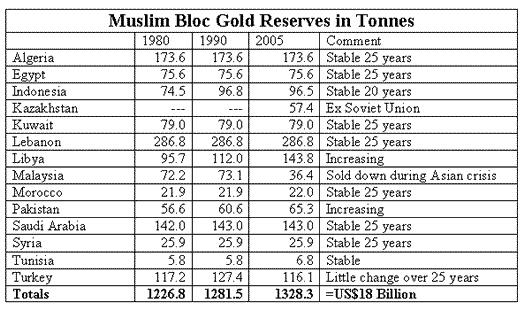
The most striking thing about these numbers is the lack of change. Many
of the holdings have not changed in 25 years. But neither have their rulers.
In many traditional societies, and this includes nations
in the Middle East, the Indian subcontinent and South East Asia, Gold has
never lost its lustre. Their Central Bank Gold Reserves are untouchable precisely
because Gold is a proven store of Value.
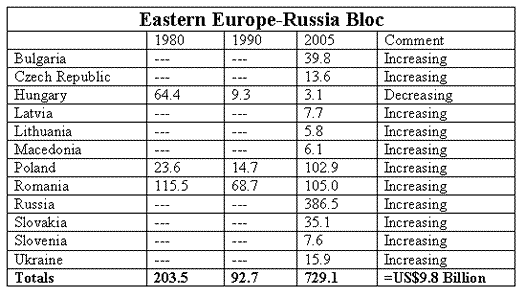
Although many of the Nations listed above are now (or soon
will be) members of the European Union I listed them with Russia because I believe their Gold reserves
are not in play for similar reasons. Unlike many Western European countries,
these ex Soviet nations have minimal Gold Reserves. Compare France with 51% of its Reserves in Gold with
Poland (only 3.9% ) or Russia (with 4.1%). In fact, one could
argue that as these nations prosper they will become Gold buyers as Russia certainly is.
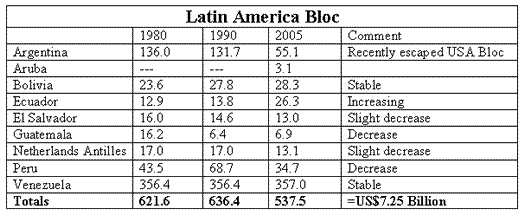
This bloc is mainly the story of Venezuela and Argentina. Brazil, Chile, Columbia and Uruguay are in
the USA bloc (see below).
Until 2003 Argentina would
have been in the USA bloc
as its Gold reserves had dropped to less than a tonne. But now it is buying
Gold and its currency no longer is tied to the US Dollar. Venezuela has had such turmoil over the years one wonders whether or not those
357 tonnes are really there. If not, they cannot be sold twice. If they
are there, given the current government, I do not think they are in play.
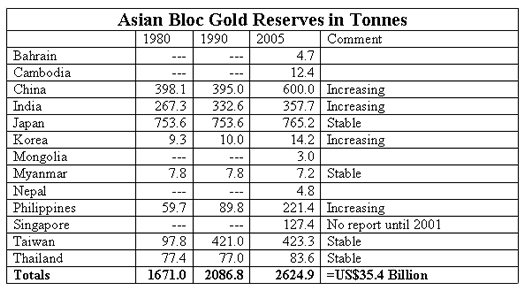
This Table does not include Indonesia and Malaysia which are in the Muslim Bloc. Like the peoples of the Middle East, Asians place great trust in Gold.
Their cities have thriving Gold Markets. China now dominates Asia
with India growing quickly.
Both nations are adding to their Gold reserves and will continue to do so.
Japan, which has the largest Asian economy,
has been in and out of recession for 15 years now. Given this and especially
their ultra low interest rates, I find it hard to believe Japan has retained all the Gold it had in
1980 but thats what they claim. Taiwan added Gold until 1990 and then stopped. We know that thousands of
tonnes of Gold have been leased but we do not know by whom. Japan and Taiwan would be good candidates.
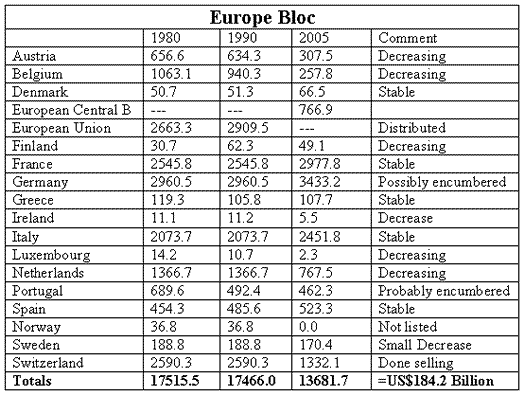
Here we have the Challenger. The Europeans wants the Euro
to be a Reserve Currency. The Euro has some Gold backing. Europeans own
half the Official Gold in the whole world. To the 13,650 tonnes listed above
we must add their portion of IMF (3217 tonnes) and BIS (206 tonnes) Gold.
During the past 15 years, while the Euro project was in its formative stage
this Bloc sold over 3800 tonnes of Gold. This stabilized the US dominated
system. However, the Europeans are now claiming they will sell very little
Gold going forward.
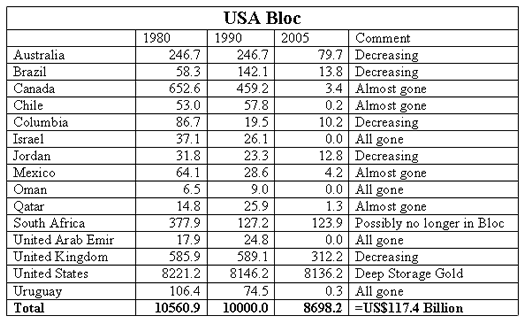
Finally we come to the USA Bloc. This is an amazing Table.
All of Americas closest allies are SOLD OUT. Australia claims to have 80 tonnes but it is probably encumbered. The UK may still have 312 tonnes but, assuming
it isnt already encumbered, this Gold may be required to obtain currency
union with the Euro zone.
The key figure of course is the American Deep Storage Gold.
If that Gold does not exist or is encumbered then the USA bloc is broke!
Conclusion:
We can summarize Global Central Bank reserves by Bloc
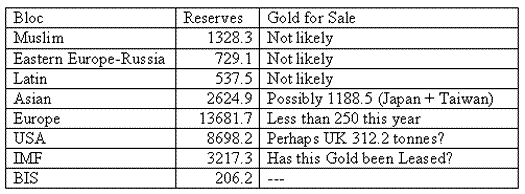
How much of this Gold is available to prevent the Gold Price
from rising? I do not know. But quite a bit of it seems off limits.
I think we can safely say that if Japanese and Taiwanese Gold has escaped
leasing thus far then it will continue to do so. The IMF Gold is potentially
saleable but as the CPM report states it is currently bogged down as it
has been for a decade.
Assuming most of the American Deep Storage Gold is no longer
available the only real source of future Gold is Europe. But Europe has a tricky role to play. They want to be part of a dual currency
Reserve System but they mustnt destroy the Dollar and bring down the whole
thing. European respect for Gold is deep rooted. The key nations are France and Germany. The French regard financial instruments with great suspicion.
They all know the story about someones great uncle who papered the water
closest with Imperial Russian bonds. Further back there is the cultural memory
of John Law and the Mississippi Bubble and then the Revolutionary Assignats.
In Germany too this feeling
runs deep for the country was ruined by fiat paper only 80 years ago. Over
the past few months we have seen a pitched battle in the German Press with
one side advocating further Gold sales and the other saying no. The need
for fresh Gold supply must be acute. The CPM report seems to indicate that
the pro Gold crowd now have the upper hand.
The United States is desperate to maintain the privileges associated with the global
Reserve currency but has recklessly disregarded the responsibility of guarding
the Dollars purchasing power. It has called upon allies to support the Dollar
either by selling their Gold Reserves as shown in the USA table or by buying US Debt paper as the Asian Central banks have done.
They have now reached a dead end. Those who once had Gold Reserves now have
empty vaults and the Asians now realize their vaults are full of irredeemable
debt.







